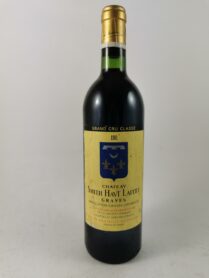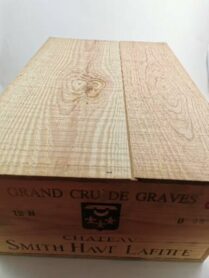Wines of Château Smith Haut Lafitte
-

Château Smith Haut Lafitte 1981
€166.80Pessac-Léognan | Red | 0,75 L
-

Château Smith Haut Lafitte 1995
€1 310.40Pessac-Léognan | White | 0,75 L
The history of Château Smith Haut Lafitte
Château Smith Haut Lafitte is a prestigious estate in the Bordeaux region. The 87-hectare estate produces wines in the Pessac-Léognan appellation.
In the 14th century, a certain Verrier Du Bosq decided to become a landowner and signed a deed of ownership for several acres of vines.
Almost two centuries later, in the mid-18th century, Château Smith Haut Lafitte was bought by a Scottish merchant named Georges Smith.
He then decided to give his name to the château, but also built the Carthusian monastery and began exporting his wines to England. The reputation and renown of Château Smith Haut Lafitte wines is attributable to Georges Smith.
In 1842, the owner of Château Smith Haut Lafitte was Lodi Martin Duffour Dubergier. He was also the former Mayor of Bordeaux and the signatory of the 1855 classification. The latter will have the chance to elevate the wine produced by Château Smith Haut Lafitte to the rank of Grand Cru Exceptionnel. Georges Smith’s work in England, and that of Lodi Martin Duffour Dubergier on the inclusion of Château Smith Haut Lafitte in the 1855 classification, enabled Maison Louis Eschenauer to distribute the château’s wines and decide to buy Château Smith Haut Lafitte in 1958.
After several ownership families, in 1990 Florence and Daniel Cathiard seized the opportunity to acquire Château Smith Haut Lafitte. Their intention is to perpetuate the noble cru’s tradition of excellence, with a philosophy of “doing everything possible to ensure that each vintage, whether red or white, reflects our magnificent terroir”. Numerous projects are underway, including renovation of the chartreuse, redevelopment of the two underground cellars, tilling of the soil, elimination of weedkillers and integration of their own cooperage. This gives Château Smith Haut Lafitte exemplary elegance.
After three years, Florence and Daniel Cathiard decided to move into the chartreuse that had previously been built by Georges Smith. Moving to the Chartreuse allowed them to devote themselves entirely to their new passion, with a highly talented and motivated team at Château Smith Haut Lafitte. Today, Château Smith Haut Lafitte’s general manager is Fabien Teitgen, sales manager Ludovic Fradin, cellar master Yann Laudheo and vineyard manager Nicolas Poumeyrau.
On the Château Smith Haut Lafitte label, 3 branches represent the three children born to Georges Smith. The fleur-de-lis represents the Verrier du Bosq family, founders of the vineyard. Finally, the emblematic crescent of the port of Bordeaux, signifying the port of the moon.
Château Smith Haut Lafitte produces several wines, including Smith Haut Lafitte Rouge and Smith Haut Lafitte Blanc, as well as two others: Hauts de Smith Blanc, Haut de Smith Rouge and Le Petit Haut Lafitte Blanc and Le Petit Haut Lafitte Rouge.
Château Smith Haut Lafitte vineyard
Château Smith Haut Lafitte is committed to organic farming. For over 30 years, Château Smith Haut Lafitte has been developing a philosophy of Bio-Precision, combining tradition and innovation in both agriculture and winery. The Cathiard family takes an interest in nature and seeks to harvest the best possible fruit without impoverishing the land.
Château Smith Haut Lafitte has been certified organic since 2019, and the wines it produces are even more pure and intense. As Château Smith Haut Lafitte is located in the heart of nature, the Cathiard family doesn’t hesitate to take advantage of all the opportunities nature has to offer.
Surrounded by greenery, seven red and white grape varieties are grown and blended to create magnificent wines in every vintage.
The soils of Château Smith Haut Lafitte are composed of Graves Gunziennes, and have two important particularities: natural soil drainage. This natural drainage process forces the roots of the vines to draw water and mineral salts from six meters below ground. The second special feature of these soils is the mirror effect of the sun, which reflects off the pebbles and helps the grapes ripen.
In addition to producing organically-farmed wines, Château Smith Haut Lafitte has also been teaching biodynamic agriculture for almost 10 years. In their opinion, it’s important, when the opportunity arises, to use the benefits of medicinal plants to prevent vine diseases. The Cathiard family grows its own plants: yarrow, yarrow, horsetail, tansy… These plants are processed so that they can be sprayed on the vines with the help of horses.
But that’s not all: as part of its commitment to organic farming, Château Smith Haut Lafitte also has a preserved, natural nursery where its own rootstocks are grown to preserve the unique identities of its grape varieties. The average age of the vines is 40 years, with an average planting density of 7,500 to 10,000 vines per hectare.
Harvesting is manual, and the grapes are gravity-fed into wooden vats to preserve all the berries. The winery’s facilities are equipped with the latest technology to create unique wines that will go on to become world-renowned.
The wines are matured in underground cellars with a thousand barrels for 12 months on lees for the château’s white wines, and for 18 months with 60% in new barrels for the red wines of Château Smith Haut Lafitte. The blending and ageing of Château Smith Haut Lafitte’s second wines take place in the stealth cellar, which is located in the heart of the vegetation and uses positive energy to limit its impact on the environment.
Matching and structure of Château Smith Haut Lafitte wines
The grape varieties used for Château Smith Haut Lafitte wines are 55% Cabernet Sauvignon, 34% Merlot, 10% Cabernet Franc and 1% Petit Verdot for the château’s red wine.
The white wine is made with 90% Sauvignon, supplemented by 5% Sauvignon Gris and 5% Semillon.
The vintages to remember for Château Smith Haut Lafitte are: 2020, 2019, 2016, 2015, 2010, 2009, 2005, 1995 and 1985.
Château Smith Haut Lafitte’s red wine has a dark, almost black color and a deep nose. Softness and elegance are combined with a bouquet of black and red fruits, complemented by delicate floral notes and warm spices. We could even add notes of smoke and flint. Beautiful complexity. On the palate, the attack is well-balanced, with power and refinement revealing themselves.
To match this bottle of Pessac-Léognan wine, we recommend: red meat, game birds, poultry or a dish in sauce. In cheese, goat’s or cow’s milk such as brie or vieux chavignol. And for dessert, a chocolate fondant – enjoy!
Interested in Pessac-Léognan wines? Treat yourself to a cuvée of this wine, which we have in stock.
See also our wines for the following domains:
